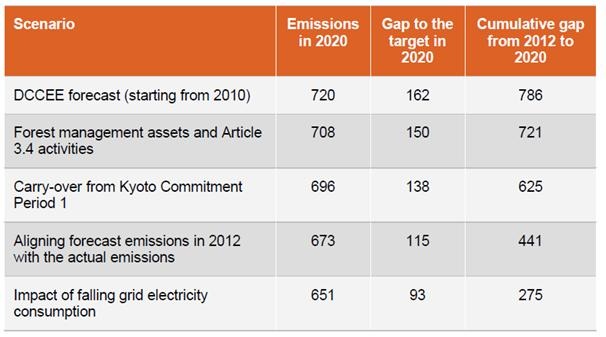Taking the axe to business as usual
In focussing on the issue of the Coalition’s inadequate budget costings for Direct Action I gave only a cursory examination to what is in fact some extraordinary news.
Instead of Australia needing to cut emissions by 755 million tonnes of CO2 to meet our minimum Kyoto II reduction target (under a no carbon price scenario), one of the key carbon emissions analysts, SKM, estimates the cut required may be just 370 million. In addition, carbon and energy advisory firm Energetics released a paper a few weeks ago suggesting that the abatement task may in fact be as low as 275 million tonnes.
This is extraordinary – the abatement task has been slashed to a half or almost a third of what official government estimates put out less than 12 months ago. For years we’ve been told by government officials, Kevin Rudd, Penny Wong plus plenty from the Coalition that the 5 per cent reduction target was very, very ambitious (disastrous if you listened to some from the Coalition).
The reason, they said, was because population and the general economy would grow in the meantime. Therefore the ambition of the emissions target shouldn’t be assessed in relation to current emissions, but rather as a cut relative to a business-as-usual forecast of rapidly growing emissions.
Instead we find the cuts required are not anywhere near as ambitious as we were led to believe.
For me it simply reinforces a finding from Grattan Institute research I authored with John Daley back in late 2010, ‘Markets to reduce pollution – cheaper than expected’. This research found that governments consistently overestimate the cost and difficulty of reducing pollution and consequently set their ambitions too weakly.
That report focussed specifically on use of market instruments to control pollution. But there are similar findings in relation to more direct regulatory measures e.g. vehicle emission controls.
A large part is due to underestimating technological and commercial innovation. Human ingenuity is an amazing thing that never ceases to surprise.
Another part is due to modellers failing to account for economically beneficial industrial restructuring (not carbon leakage where emissions increase as a consequence of offshoring industry). But I have to also admit that some just comes down to government simply fudging the rules in a range of subtle ways that help-out polluters.
All of these are evident in the downscaling of Australia’s abatement task to meet its minimum Kyoto II obligations as shown by Energetics. The table below from its report details the various reductions in Australia’s abatement task relative to the government’s projections released in 2012 (“DCCEE Forecast”).
The key number to focus on is the cumulative gap over 2013 to 2020 because our Kyoto II international obligations are not for the single year of 2020, but rather the entire period of 2013-2020. Even if emissions substantially exceed the target in 2020, it can be offset by lower emissions in the prior years.

Firstly there’s the fudging.
Changes to international accounting for forest management and land use drop the task from 786 million to 721 million. Then we get to carry over surplus credits from undershooting our Kyoto I obligations, which reduces this further to 625 million.
In addition, as explained here, the actual emissions for 2011 and 2012 have fallen well below those contained in the government’s projections work. Because this drop-off occurred while economic growth was reasonably robust, Energetics reasons this is probably not a one-off cyclical blip but rather reflective of more longer term changes. Aligning future year’s emissions with the lower actual emissions in 2011 and 2012 drops the gap to 441 million tonnes.
Lastly there is the drop away in demand for electricity which has been extensively covered in Climate Spectator. Taking into account AEMO’s latest medium growth scenario reduces the gap to 336 million tonnes. However Energetics argues that AEMO’s medium scenario probably overestimates likely electricity demand growth and instead thinks the low growth scenario is more probable. This brings the gap down to 275 million tonnes.
Naturally such forecasts are subject to considerable uncertainty. Energetics points out that escalating gas prices might drive a switch to more emissions intensive coal which could increase emissions.
A fall in the Australian dollar (which we’re already starting to see) could lead to recovery in some emissions intensive manufacturing output. And of course there is some concern the Coalition might scale back the renewable energy target to align with Origin Energy and EnergyAustralia’s demands.
If Energetics’ forecast is accurate it vastly improves the feasibility of the Coalition achieving its minimum emissions abatement target. However I was incorrect to imply yesterday that Energetics research analysed whether the Coalition’s budget was sufficient to bridge this smaller gap. While their Executive Director Jon Jutsen has pointed out for many years that he believes there is an extremely large pool of low cost abatement from energy efficiency, Energetics does not feel it has enough information on the detail of the Direct Action policy to evaluate whether it could bridge the gaps.
So we still await the Coalition’s own evidence to support its budget costings.
















